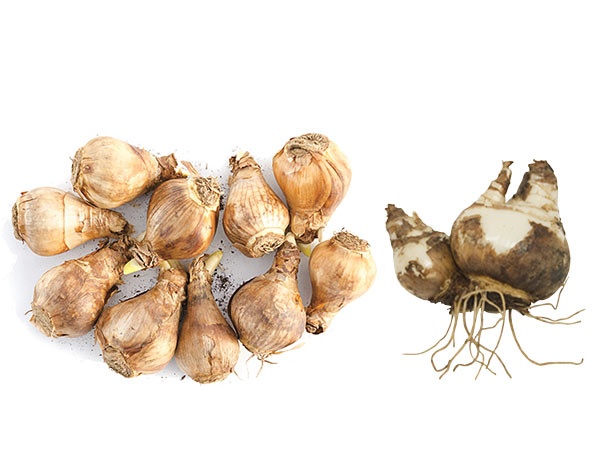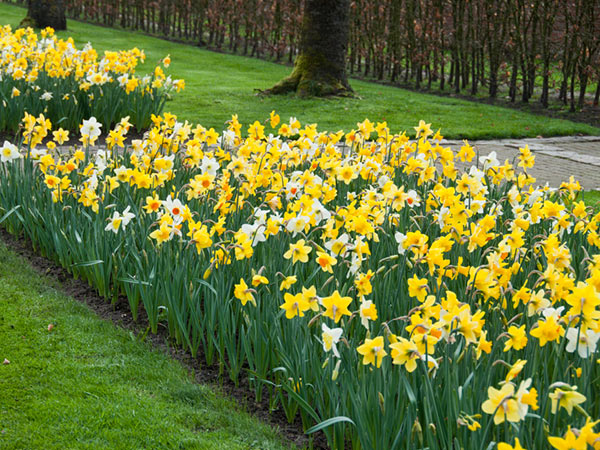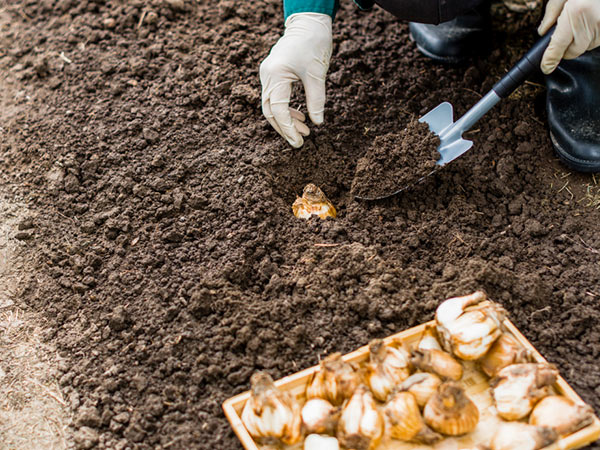Nothing announces the arrival of spring like daffodils. Their cheerful, trumpet-shaped flowers splash gardens and landscapes with golden yellows and other brilliantly colored hues. These spring blooms are also a favorite in cut flower arrangements.
While their bloom times can vary, daffodils, also called narcissus, generally burst into bloom after crocuses and before tulips. They are some of the easiest of the spring-blooming bulbs to grow. Suitable for zones 3-8, daffodils can be grown throughout much of the United States. To see if daffodils will grow in your area, you can check our hardiness zone finder.
It’s easy to fit daffodils into your gardening style. Depending on the cultivar, they grow 14-24 inches tall, and look right at home in formal gardens, naturalized areas, mixed perennial beds and other locations. For the best effect, we recommend planting daffodils in groups of five or more. Some gardeners, though, plant hundreds of daffodil bulbs to create a burst of color in the springtime.
Daffodils contain a toxic liquid called lycorine in their bulb and stem, making them deer resistant. Because daffodils are deer resistant and rodent resistant, they’re a favorite of gardeners who live in areas that have frequent deer and other wildlife visitors.

How to Select Daffodils
When people think of daffodils, yellow-hued varieties are often the first that come to mind. But thanks to modern breeding efforts, gardeners can now choose from hundreds of different daffodil cultivars, including those with double blooms and in hues of yellow, orange, white, salmon and more. Select daffodils that fit your color scheme and preference.
Daffodils are also available in a range of bloom times. By selecting early-season, mid-season and late-season varieties, you can extend the daffodil season up to three months. Browse daffodil bulbs from KVB for one of the best and most varied selection of daffodil flowers.
When selecting daffodil bulbs for fall planting, select plump, large flower bulbs. The larger daffodil bulbs will produce larger plants.
Where to Plant Daffodil Bulbs
Daffodils require well-drained soil and full sun to partial shade. Some daffodil varieties are more suitable to partial shade or dappled sunlight, so be sure to check the light requirements on each variety. Partial shade is usually defined as 4-6 hours of direct sunlight daily. Because daffodils bloom in the spring, before many deciduous trees leaf out, they can often be planted under trees or in woodland areas.
Well-drained soil is a must for daffodils. Bulbs don’t like wet feet. If planted in poorly drained soil, daffodil bulbs will rot.
Growing Daffodils in Containers
Daffodils can also be grown in containers, providing the containers have good drainage. Make sure the container or pot that you use has drainage holes.
Like many other fall planted bulbs, daffodils or narcissus require a cold period that allows their roots to develop and for them to get ready for spring. This is why daffodils don’t grow well in far southern parts of the United States. If growing daffodils in containers, many northern gardeners bring the containers to a more protected space, like an unheated garage, over winter so the bulbs don’t freeze.
When to Plant Daffodil Bulbs
Daffodil or narcissus bulbs are planted in the fall, when the weather starts to cool and before hard freezes set in. In more northern regions, daffodil bulbs can be planted in late September through October, while in more southern regions, the planting time is October through November. A good rule of thumb for fall planting bulbs is to let soil temperature be your guide on when to plant daffodils. The soil should be below 60 degrees F. but not frozen.
How to Plant Daffodil Bulbs
Because daffodil bulbs need well-drained soil, the first step is to make sure your soil is well-drained. Mixing aged manure or compost into the soil can improve the drainage.
Next, either prepare a bed for planting daffodil bulbs or dig individual holes for the bulbs. If digging individual holes, people often use a bulb planter or auger. For bulb planting supplies, visit our garden fertilizer and tools page.
Make sure the planting hole is deep enough. The general rule of thumb is to plant the daffodil bulb about three times the diameter of the bulb. That means that large daffodil bulbs should be planted about 6 inches deep. Bulbs don’t like to be crowded, so place the daffodil bulbs about 4 inches apart. If planting in a container, the bulbs can be closer together, but they should not be touching.
At planting time, you can feed the daffodil bulbs with Van Bourgondien 100% Natural Bulb Food. Avoid using a strong commercial fertilizer or fresh manure at planting time.
Set the bulb so that the pointy end is up. Cover with dirt. After planting, water the bulbs well and cover with a light mulch.

How to Grow Daffodils
In the springtime, daffodils require little care. They have average water needs, or require about an inch of rainfall weekly. If the springtime is really dry, they may require some additional watering.
When the daffodils bloom, enjoy the show. Daffodils also make wonderful cut flowers, so cut some for indoor arrangements or bouquets.
When the daffodil flowers fade, deadheading or cutting the spent flower heads, gives a neater appearance. Don’t cut the foliage, though, as it’s making food for next year’s flowers. Allow the foliage to naturally fade or die back. Some gardeners plant perennials around daffodils to hide the fading foliage.
If fertilizing or feeding your daffodil bulbs, the time to do this is right after they stop flowering. We recommend using an all-natural plant food.
Dividing Daffodil Bulbs
Daffodils naturalize well and will come back year after year. They produce more bulbs each year. If the daffodils become too crowded they may not perform as well. This means they are ready to divide. Bulb division should be done after the foliage has completely faded away.
To be sure that you can locate your daffodil bulbs, we recommend marking the ones you plan to dig up and divide. That way, they’re easy to find once the foliage has faded.
Dig the bulbs up and divide them. You can give the extra bulbs to a friend or replant them in another location that will benefit from the springtime cheer of daffodils.

